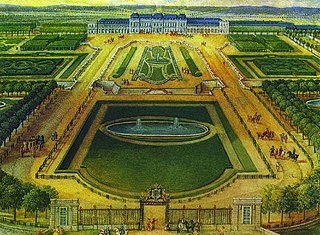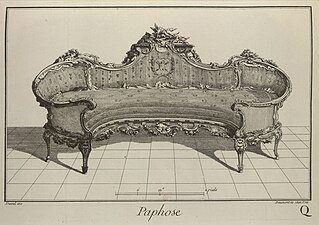
François Boucher was a French painter, draughtsman and etcher, who worked in the Rococo style. Boucher is known for his idyllic and voluptuous paintings on classical themes, decorative allegories, and pastoral scenes. He was perhaps the most celebrated painter and decorative artist of the 18th century.

Étienne François, marquis de Stainville, duc de Choiseul, KOHS, OGF was a French military officer, diplomat and statesman. From 1758 to 1761 and from 1766 to 1770, he was Foreign Minister of France and had a strong influence on France's global strategy throughout the period. He is closely associated with France's defeat in the Seven Years' War and subsequent efforts to rebuild French prestige.

The Prix de Rome or Grand Prix de Rome was a French scholarship for arts students, initially for painters and sculptors, that was established in 1663 during the reign of Louis XIV of France. Winners were awarded a bursary that allowed them to stay in Rome for three to five years at the expense of the state. The prize was extended to architecture in 1720, music in 1803 and engraving in 1804. The prestigious award was abolished in 1968 by André Malraux, then Minister of Culture, following the May 68 riots that called for cultural change.

Jean-François de La Harpe was a French playwright, writer and literary critic.

Louis-Sébastien Mercier was a French dramatist and writer, whose 1771 novel L'An 2440 is an example of proto-science fiction.

Jean-François-Thérèse Chalgrin was a French architect, best known for his design for the Arc de Triomphe, Paris.

Nicolas Bernard Lépicié was a French painter and teacher of painting, the son of two well-known engravers at the time, François-Bernard Lépicié and Renée-Élisabeth Marlié. Lépicié was famous in his lifetime, and compared to Chardin and Greuze.

Jean-François Pierre Peyron was a French Neoclassical painter, printmaker, and art collector.
The Commission des Sciences et des Arts was a French scientific and artistic institute. Established on 16 March 1798, it consisted of 167 members, of which all but 16 joined Napoleon Bonaparte's campaign in Egypt and produced the Description de l'Égypte. More than half were engineers and technicians, including 21 mathematicians, 3 astronomers, 17 civil engineers, 13 naturalists and mining engineers, geographers, 3 gunpowder engineers, 4 architects, 8 artists, 10 mechanical artists, 1 sculptor, 15 interpreters, 10 men of letters, 22 printers in Latin, Greek and Arabic characters. Bonaparte organised his scientific 'corps' like an army, dividing its members into 5 categories and assigning to each member a military rank and a defined military role beyond his scientific function.

Gabriel Huquier (1695–1772) was an entrepreneurial French draughtsman, engraver, printmaker, publisher, and art collector, who became a pivotal figure in the production of French 18th-century ornamental etchings and engravings

Johann Eleazar Zeissig, also known as Schenau, was a German genre, portrait and porcelain painter, and engraver; director of the Royal Academy of Arts in Dresden.

Jean Marot was a French architect and engraver of architectural views. Little has survived of his own architectural work, but his engravings of the works of others, primarily those published in the volumes referred to as the Petit Marot and the Grand Marot (1686), were highly esteemed by his contemporaries and remain, despite numerous inaccuracies and distortions, among the most important sources concerning architecture in France up to the early part of the reign of Louis XIV.
Jean-Georges Sieber was a German born French musician and music publisher.

Gilles Demarteau or Gilles Demarteau the Elder was an etcher, engraver and publisher who was active in Paris for his entire career. He is one of the persons to whom has been attributed the invention of the crayon manner of engraving. He is recognized as playing an important role in the development of this engraving technique. He was one of the key reproductive engravers and publishers of the work of François Boucher.

Louis-François Jauffret was an 18th–19th-century French educator, poet and fabulist. Gaspard-André Jauffret, bishop of Metz, Jean-Baptiste Jauffret, director of the imperial institution of the deaf in St. Petersburg and Joseph Jauffret, master of requests to the Conseil d'État, were his brothers.
Jean-Baptiste-Michel Renou de Chauvigné dit Jaillot was a geographer, French cartographer, historian and bookseller in Paris.

The Château de Chanteloup was an imposing 18th-century French château with elaborate gardens, compared by some contemporaries to Versailles. It was located in the Loire Valley on the south bank of the river Loire, downstream from the town of Amboise and about 2.3 kilometres (1.4 mi) southwest of the royal Château d'Amboise. From 1761 to 1785 Chanteloup belonged to King Louis XV's prime minister, the Duke of Choiseul. The château was mostly demolished in 1823, but some features of the park remain, notably the Pagoda of Chanteloup, a significant tourist attraction.

Sophonisbe is a tragedy in five acts by Voltaire. The play, printed in 1769 but dated 1770, was a stage failure when it premiered on 15 January 1774.





















